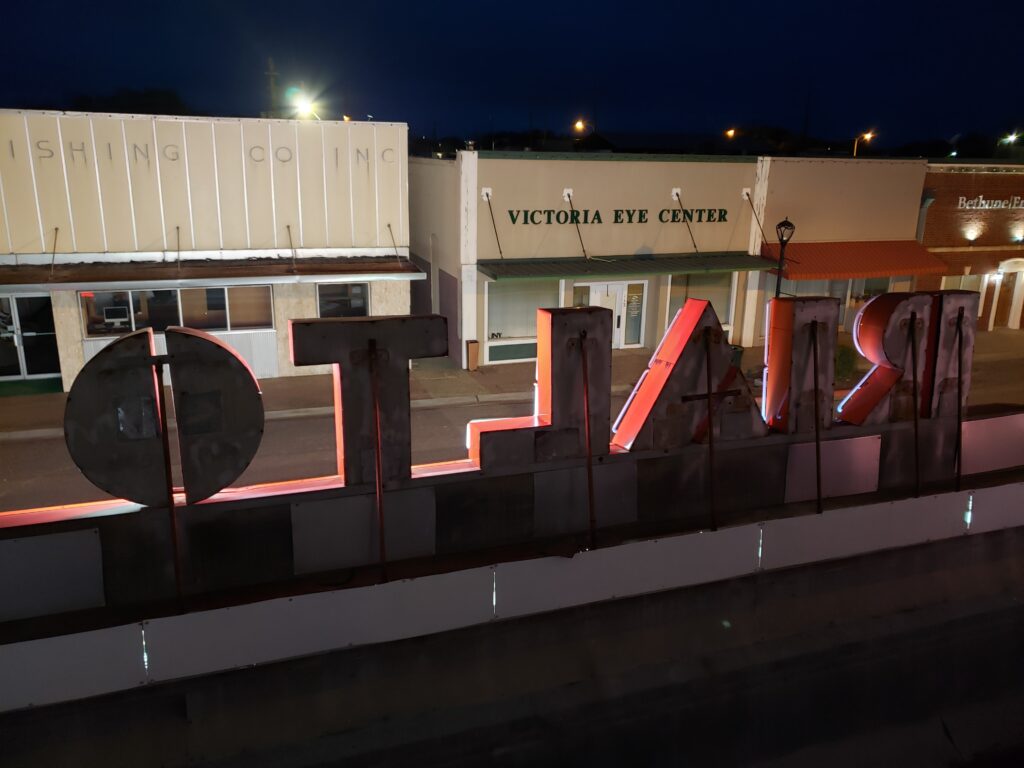First Rialto Theater Building: 1922
On March 2, 1922, Henry and Sydney Hall announced their plans to build a $25,000 two-story brick and tile motion picture theater in Beeville. They purchased 50 feet by 140 feet site at 114 North Washington Street which was in the main commercial district as it still is today.
Homer Boots served as foreman during the five month construction. The Rialto Theater opened on Saturday, August 19, 1922 with the first film “The Three Musketeers” starring Douglas Fairbanks. Admission was twenty-five cents for adults and ten cents for children.
Opening night witnessed two problems: the delay of the arrival of a $10,000 pipe organ which had been detained by a railroad strike in Cincinnati. Also a fuse was blown when the marquee was initially lighted. The Halls acted quickly to replace the music: an orchestra was hired to provide the accompaniment to the silent film. The blown fuse was quickly replaced which allowed the show to go on. More than 1,300 tickets for two showings were sold that night.
According to Henry Hall, Jr., the Rialto Theater in Beeville was originally built to be the flagship theater of the Hall Brothers Industries theater chain. The theater was designed with a stage large enough for vaudeville performances as well as large road attractions.
W.C. Stephenson, the architect of the 1912 present day Bee County Courthouse and approximately 53 other historical structures in Beeville, designed the original 1922 Rialto Theater. Stephenson was a Shakespearean actor before he trained to be an architect. He was also a sculptor and aided in making the death mask of 25th President William McKinley who was assassinated at the 1901 Pan-American Exposition in Buffalo where Stephenson was working.
Architectural Design
Stephenson’s design of the Rialto was Classical Revival and was compatible with the adjacent commercial structures. Where this building differed was in the installation of over two miles of electrical wiring which connected 420 lights, a unique typhoon cooling system as well as a hot air system.
Theater Pioneer in Unique Features
The Hall Brothers are also credited with establishing the first radio station in greater South Texas (KFRB) on December 27, 1924. The transmitting station was located on the roof of the Rialto Theater. The station was eventually sold to KRIS, the first radio station of Corpus Christi .
Sound was introduced to the Rialto Theater on October 18, 1929. The Hall Brothers installed a state-of-the-art Western Electric sound system which was designed for the theater by Bell Laboratories.
John Eberson Redesigns Rialto in 1935
In 1935, a fire was started by accident in the basement which destroyed the interior. During the latter part of 1935, the Hall Brothers hired John Eberson (see photo below), the well-known designer of atmospheric theaters (Majestic Theaters in Dallas and San Antonio) to redesign the Rialto.
During 1935, Eberson redesigned the theater and transformed it into an Art Deco, Moderne style. The design successfully incorporated office, commercial and entertainment functions. Barry Moore of Gensler Architects in Houston states that the Rialto is one of the last works of John Eberson.
Rialto 1922-1986
Rialto Theater 1936The Rialto Theater managed to stay open from 1922 to 1986 even though there were difficult times for Beeville as well as our nation. For example, during the Great Depression in the 1920’s, the Halls hosted “Bank Night” where prizes were awarded to attract patrons.
During World War II, the Rialto used a star studded program to promote the sale of U.S. War Bonds. Numerous entertainment personalities and movie stars have visited Beeville and the theater. Such celebrities have been John Wayne, Jeff Chandler, Gail Storm, Keenan Wynn, Jessy Lasky, Richard Widmark, and Chill Wills.
In 1967, the basement of the theater flooded after excessive rain from Hurricane Beulah. Except for a brief period in 1935, the theater functioned for 64 years until it closed in 1986.
Aside from the interior beauty, people remember the Rialto for its unique and original ‘Typhoon’ circulating air system that was in the back of the theater. Later, a mammoth “Buffalo” washed air system was installed complete with an ice making plan capable of producing 45 tons of ice each day. This system helped the theater interior maintain a 20 degree drop inside, regardless of the exterior temperature.
Another addition to the 1936 Rialto were the headphones installed in the chairs to accommodate the people who had auditory impairments. These earphones are found tucked within the white enamel armrest of each chair at the end of each row.
The Rialto celebrated its 85th birthday in 2007. For example, during the 2006-2007 season, the Rialto has included a performance of “The Messiah,” the Patsy Cline Band, a Valentine play and a unique Children’s Theater and Workshop.
Unique Features/Place in Texas History
As stated earlier, the Rialto also was the home of the first AM radio station in greater South Texas. It also had the first auditory seats for the hearing impaired as well as the Typhoon cooling system. Because of these features and the original design by John Eberson, the Rialto Theater is one of the eight Texas theaters to be nominated for the National Register of Historic Places.


